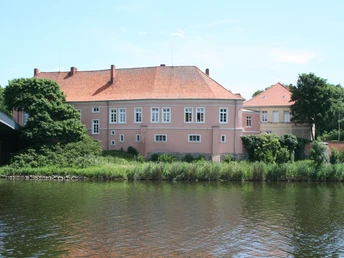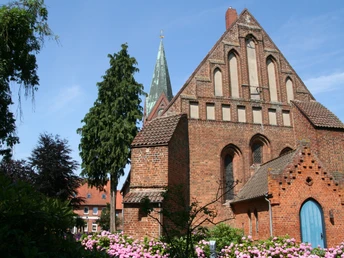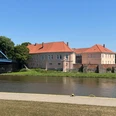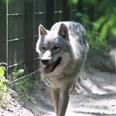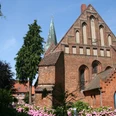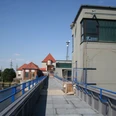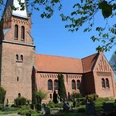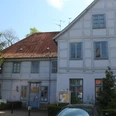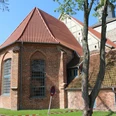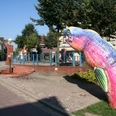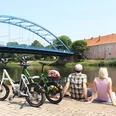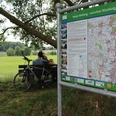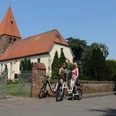- 3:09 h
- 50.02 km
- 19 m
- 26 m
- 8 m
- 31 m
- 23 m
- Start: Hoya
- Destination: Hoya
Discover part of the Weser Cycle Path as a circular route on the main and alternative route. You can change sides of the Weser several times and determine the length of your cycle tour yourself.
Sights along the route: Hoya old town with St. Martin's Church and former count's castle, Wolfcenter Dörverden, Weser weir Dörverden, old town with Verden Cathedral, German Horse Museum, cathedral lords' house, Weser passenger boat trip
The town of Verden (Aller) at the confluence of the Aller and Weser rivers is a suitable starting and finishing point for the circular tour between Verden and Hoya. Verden's townscape is characterized by the towering cathedral (1290 - 1490) - Gothic architecture with the first ambulatory choir in Germany.
Visitors can trace the development of the town from the Norderstadt (bourgeois town) and Süderstadt (episcopal town) on a model of the town from 1663 in the Domherrenhaus - Historical Museum. The museum's depiction of an elephant hunting event 120,000 years ago is of supra-regional significance.
How big was the horse 50 million years ago? Visitors to the German Horse Museum directly behind the cathedral can learn informative facts about horses in culture, history, art and sport. From Verden, the route leads across the Aller into the so-called Aller-Weser triangle. You reach the Weser for the first time at Rieda. Between Geestefeld and Stedorf, the cycle path runs parallel to the lock canal.
It is possible to cross the lock canal (open from April 25 to October 15). You will reach the weir system and the Dörverden hydroelectric power station. The lock system is well worth a visit.
If you decide to cycle the entire circular route, the path leads over a narrow concrete bridge on the Weser dyke into the village of Dörverden. The backdrop to the village is dominated by the windmill and church tower. From Dörverden, the path leads to Barme. A radio tower, known as the "Barmer Spargel", can be seen from afar.
In Barme, the Wolfcenter Dörverden is a destination worth seeing. Here you can find information on "The return of the wolf to Germany and Lower Saxony". Various wolf packs, guided tours and a museum are on offer.
Continue south along the B215. Before you reach the town sign for Hassel, turn right onto Jübberweg. You will then reach the state road 330, which takes you directly to Hoya. The Alhuser Ahe nature reserve is a good place for a short detour. The old count's town of Hoya invites you to visit the Martinskirche cultural center.
It is worth making a short detour to the village of Bücken, three kilometers away, with its twin-towered collegiate church of St. Matemiani et St. Nicolai, which is known beyond the borders of the state for its remarkable wealth of important art treasures. From Hoya, the route leads past idyllic hamlets through the municipality of Hilgermissen with its various districts, where cozy restaurants invite you to linger. From Wienbergen you reach the barrage and the Döverden hydroelectric power station. You should take a break at the Alveser See lake in Eitzendorf when cycling the entire circular route. It's definitely worth it! This oxbow lake of the Weser stretches idyllically over several kilometers and is a designated landscape conservation area.
You then reach the village of Oiste, which was first mentioned in a document in 860. From Oiste, the trail leads to Blender. Lake Blender is part of the old Weser bed. Blender was first mentioned in a document in 1186. You reach the Weser bridge near Hutbergen via Varste. Shortly after the village, you will once again have the historic backdrop of the town of Verden (Aller) in front of you.
Safety information:
Sights along the route: Hoya old town with St. Martin's Church and former count's castle, Wolfcenter Dörverden, Weser weir Dörverden, old town with Verden Cathedral, German Horse Museum, cathedral lords' house, Weser passenger boat trip
The town of Verden (Aller) at the confluence of the Aller and Weser rivers is a suitable starting and finishing point for the circular tour between Verden and Hoya. Verden's townscape is characterized by the towering cathedral (1290 - 1490) - Gothic architecture with the first ambulatory choir in Germany.
Visitors can trace the development of the town from the Norderstadt (bourgeois town) and Süderstadt (episcopal town) on a model of the town from 1663 in the Domherrenhaus - Historical Museum. The museum's depiction of an elephant hunting event 120,000 years ago is of supra-regional significance.
How big was the horse 50 million years ago? Visitors to the German Horse Museum directly behind the cathedral can learn informative facts about horses in culture, history, art and sport. From Verden, the route leads across the Aller into the so-called Aller-Weser triangle. You reach the Weser for the first time at Rieda. Between Geestefeld and Stedorf, the cycle path runs parallel to the lock canal.
It is possible to cross the lock canal (open from April 25 to October 15). You will reach the weir system and the Dörverden hydroelectric power station. The lock system is well worth a visit.
If you decide to cycle the entire circular route, the path leads over a narrow concrete bridge on the Weser dyke into the village of Dörverden. The backdrop to the village is dominated by the windmill and church tower. From Dörverden, the path leads to Barme. A radio tower, known as the "Barmer Spargel", can be seen from afar.
In Barme, the Wolfcenter Dörverden is a destination worth seeing. Here you can find information on "The return of the wolf to Germany and Lower Saxony". Various wolf packs, guided tours and a museum are on offer.
Continue south along the B215. Before you reach the town sign for Hassel, turn right onto Jübberweg. You will then reach the state road 330, which takes you directly to Hoya. The Alhuser Ahe nature reserve is a good place for a short detour. The old count's town of Hoya invites you to visit the Martinskirche cultural center.
It is worth making a short detour to the village of Bücken, three kilometers away, with its twin-towered collegiate church of St. Matemiani et St. Nicolai, which is known beyond the borders of the state for its remarkable wealth of important art treasures. From Hoya, the route leads past idyllic hamlets through the municipality of Hilgermissen with its various districts, where cozy restaurants invite you to linger. From Wienbergen you reach the barrage and the Döverden hydroelectric power station. You should take a break at the Alveser See lake in Eitzendorf when cycling the entire circular route. It's definitely worth it! This oxbow lake of the Weser stretches idyllically over several kilometers and is a designated landscape conservation area.
You then reach the village of Oiste, which was first mentioned in a document in 860. From Oiste, the trail leads to Blender. Lake Blender is part of the old Weser bed. Blender was first mentioned in a document in 1186. You reach the Weser bridge near Hutbergen via Varste. Shortly after the village, you will once again have the historic backdrop of the town of Verden (Aller) in front of you.
Safety information:
- Throughout the entire tour, please note that the cycle paths are used at your own risk
- No guarantee is given for the usability of the cycle paths
- In towns, increased attention is generally required
- Please use existing cycle paths
- Dangerous spots must be expected on the tour, such as bollards, barriers to traffic
- .e.g. bollards, barriers and unsecured crossings of main roads - this advice applies in particular to cycling families with small children.
Waypoints
Start
Good to know
Best to visit
suitable
Depends on weather
Author
Mittelweser-Touristik GmbH
Lange Straße 18
31582 Nienburg/Weser
Organization
Mittelweser-Touristik GmbH
License (master data)
Mittelweser-Touristik GmbH
Our recommendations
Nearby

